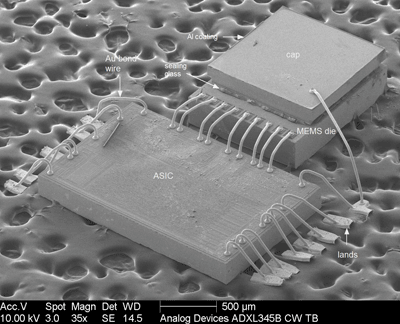Throughout its history, the semiconductor industry has grown by integrating more and more functionality into a single, monolithic device. From the initial fabrication of two transistors on a single crystal to today’s manufacturing of microprocessors with millions of devices, relentless adherence to Moore’s Law has brought new capabilities and opened new markets to integrated circuits.
With the advent of microelectomechanical systems, it has similarly been assumed that the key to success would be to integrate the MEMS device onto the same piece of silicon that held the other digital and analog circuitry needed to make a complete functional system. But this approach has recently been called into question.
In an article called “Inside Analog Device’s New MEMS Strategy” on the MEMS Industry Association blog (http://memsblog.wordpress.com/), St. J Dixon-Warren of Chipworks notes that Analog Devices, which had been building monolithic devices based on their iMEMS since 1991, is now moving to a two-IC approach with its latest MEMS product, the ADXL345 accelerometer (see photo ). Dixon-Warren writes, “The integration of BiCMOS and MEMS process technology onto a single die [in the iMEMS process] represented a significant technological achievement; however, the price of this integration was significant limitation on the complexity of the circuitry available to device designers, and limitations on the range of MEMS processing possible.

“After more than twenty years, Analog has decided to abandon their integrated iMEMS technology, and adopt the more common strategy of using a separate MEMS die and ASIC die wire bonded together in a single package…. Abandoning their integrated iMEMS technology brings a number of benefits for Analog Devices. It allows the use of more advanced process technology in the ASIC, thus enabling greater functionality, [and] allows them to more easily adopt a foundry strategy, with the possibility of separate foundries for the MEMS and ASIC die.”
So for now, it looks like the road ahead is paved with multiple-IC MEMS devices.
Richard Comerford
Advertisement
Learn more about Electronic Products Magazine





